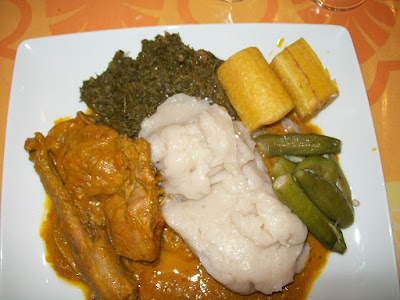The geographical areas now designated as Angola where first first entered into contact with the Portuguese in the late 15th century. Angola became a Portuguese colony in 1491 and an Overseas Territory of Portugal in 1951.
The name of the country is derived from the Kimbundu word N'gola, meaning King - N'gola (King) Kiluange was the king of the Ndongo Kingdom at the time of the Portuguese arrival.
Angola's capital Luanda was founded on January 25, 1575 with one hundred families of settlers and four hundred soldiers.
Today approximately a third of the Angolans live in Luanda. It is the world's third most populous Portuguese-speaking city, behind only São Paulo and Rio de Janeiro,
Practically no white settlement was attempted during this time, owing to the much greater profits to be made in the slave trade; by 1845 there were still only 1800 Europeans in all of Angola. The slave trade went on almost uninterrupted throughout the 19th century. By that time an estimated three million people had been exported.
Today approximately a third of the Angolans live in Luanda. It is the world's third most populous Portuguese-speaking city, behind only São Paulo and Rio de Janeiro,
 |
| View of Luanda bay, February 2013. By Fabio Vanin |
Practically no white settlement was attempted during this time, owing to the much greater profits to be made in the slave trade; by 1845 there were still only 1800 Europeans in all of Angola. The slave trade went on almost uninterrupted throughout the 19th century. By that time an estimated three million people had been exported.
The Angolan War of Independence started in 1961 when a protest by agricultural workers in Baixa de Cassanje, Portuguese Angola, turned into a revolt.
The Angolan War of Independence lasted until January 15, 1975, when Portugal and the nationalist factions UNITA, the MPLA and the FNLA signed the Alvor Agreement, ending the conflict.
The national flag of Angola came into use on November 11, 1975, when Angola gained independence from Portugal. The flag was designed by Henrique Onambwé and is based on the flag of the Popular Movement for the Liberation of Angola (MPLA), one of the several groups that fought for Angolan independence.
The flag is a horizontal bicolour of red and black, with a yellow half gear wheel crossed by a machete and crowned with a star in the center. The red color symbolizes socialism, the black color symbolizes Africa, the yellow gear wheel symbolizes industry, the machete symbolizes agriculture, and the star symbolizes hope and international solidarity.
November 11 is celebrated annually in Angola as Independence Day.
Civil war followed the granting of full independence on November 11, 1975. The war continued on and off until a peace treaty was signed by The Angolan government and UNITA rebels on April 4, 2002. Approximately 500,000 people lost their lives in the civil war.
Angola is the seventh largest country in Africa, comprising an area more than twice as large as France and the Low Countries combined. it shares a border with Zambia, Namibia, Congo and the Atlantic Ocean.
 |
| Decommissioned UNITA BMP-1 and BM-21 Grads at an assembly point. By Ernmuhl |
Angola is the seventh largest country in Africa, comprising an area more than twice as large as France and the Low Countries combined. it shares a border with Zambia, Namibia, Congo and the Atlantic Ocean.
According to 2014 census data, Angola had a population of 25,789,024 inhabitants in 2014.
Portuguese is the official language. The 2014 population census found that about 71% of the nearly 25.8 million inhabitants of Angola speak Portuguese at home. 46 other languages are spoken in the country, mostly Bantu languages, Umbundu is the most widely spoken Bantu language, spoken by about 23 percent of the population.
The largest religious denomination is Catholicism, to which adheres about half the population. Roughly 26% are followers of traditional forms of Protestantism, but over the last decades there has in addition been a growth of Pentecostal communities and African Initiated Churches.
Angola is a potentially rich agricultural country, with fertile soils, a favorable climate, and about 57.4 million ha of agricultural land, Before independence in 1975, Angola was a major exporter of bananas, coffee and sisal, but the Civil War destroyed fertile countryside, left it littered with landmines and drove millions into the cities.
About 80% of farmers throughout Angola are smallholders. They cultivate very small plots of land, with very low agricultural productivity.
Funge a paste or porridge made from the cassava or corn flour is a common dish, which in poorer households is often consumed at every meal.
Moamba de galinha (chicken cooked in a red palm oil sauce called moamba de dendem) is often served with rice and funge.
The highest peak in Angola is Monte Moco (2,620 metersor 8,600 feet ), situated in Huambo.
Angola is rich in minerals, and among the country’s most notable are diamonds and oil. They make up 60% of Angola's economy, almost all of the country's revenue and all of its dominant exports.
The basic unit of currency is the kwanza, which replaced the Angolan escudo in 1977. The currency derives its name from the Kwanza River.
It is illegal under Angolan law to take Kwanza out of the country and as such you can't change the currency overseas.
Angola's traditional music, the semba has influenced several other types of music, including the samba of Brazil.
Barceló de Carvalho, the Angolan singer popularly known as Bonga, is arguably the most successful Angolan artist to popularize semba music internationally.
Source Funk & Wagnells Encyclopedia


No comments:
Post a Comment